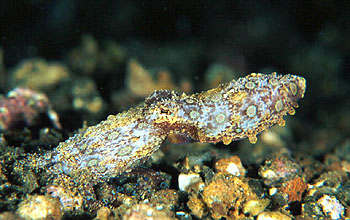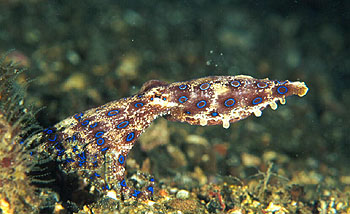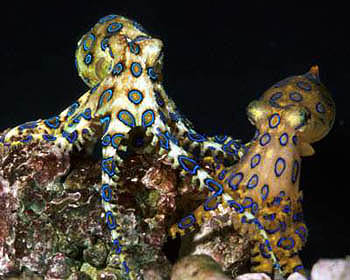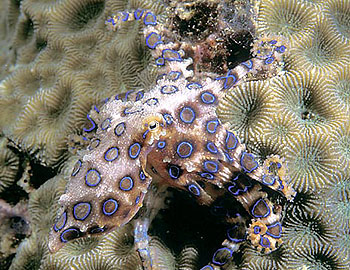
Above: Blue ringed octopus without warning colour.
Below: The same octopus with warning colour.

Photos: Jeff Dudas, Lines and Shadows.
 Above: Blue ringed octopus without warning colour. Below: The same octopus with warning colour.  Photos: Jeff Dudas, Lines and Shadows. |
Of mushrooms and women it is said, the most beautiful are the most dangerous. That saying might as well go with octopuses, as blue ringed octopuses are among the most beautiful and colourful octopus species.
Octopuses mainly hunt crustaceans, but also other molluscs, even their own kind. So when an octopus attacks its prey, it can change very fast from an attacker to a defender or even be hunted itself. So most octopuses first grab their prey with the arms and then try to immobilize it, so it cannot defend itself, for example with its pincers. With the hard horny beak cephalopods are the only mollusc group to have, a hole is then bitten into the prey's armour. Now the octopus can inject saliva into the prey's interior. An octopus' saliva not only contains digestive enzymes, but also a mixture of poisons that paralyse the prey and soften its internal organs, so the octopus can suck them up.
A group of small octopuses from tropical to subtropical sea regions north-east of Australia has become famous not only due to their remarkable warning colour but also due to their using venom against prey as well as against attackers. These octopuses are called blue ringed octopuses, as they show differently shaped rings or stripes of blue. Their colour remarkable even among octopuses only shows when the blue ringed octopus is excited. In an unexcited state it is but a small pale brown octopus. Blue ringed octopuses usually live on rocky shores and reefs. After storms they sometimes come near the shore to hunt for crabs and other crustaceans in tide pools.
|
The Nature of Science: Deadly Blue-ringed Octopus. Source: YouTube. |
The blue ringed octopus' venom is so effective; it can even be harmful to humans. It is said that the bite itself is hard to be felt. The venom's effect is only obvious when respiration ceases and even stops. The venom causes an inhibition of muscles that are needed for conscious motions of the body including respiration and locomotion. Unconscious muscles such as the heart and the iris ring muscle are not influenced. That means, while respiration and movement are stopped, heart and brain keep on working - the bitten person dies of suffocation in plain conscience. However, the venom has a short time of effectiveness - when artificial respiration is applied, the person can fully recover.
In total three casualties have been reported for hundred years, of which two have been in Australia and one in Singapore. The danger is nevertheless so present in Australia that in certain regions there are special signs saying "Danger - Blue Ringed Octopuses". Actually, it is not quite known, if all species of the genus are dangerous, as not all of them have been researched so far and some species regularly are handled by humans without any known casualties.
The blue ringed octopus' venom, however, is not produced by the octopus itself, but by symbiotic bacteria inhabiting the octopus' salivary glands. Those bacteria are transferred from the mother to the young - even the eggs already contain sufficient amounts of venom to be harmful. Like in cone shells the venom does not consist of one substance but is a cocktail of several poisons obviously species specific. Main part of the poisonous mix is tetrodoxin, a neural toxin. This is also found in the venom of puffer fish (Tetraodontidae) and notaspidean sea slugs (Pleurobranchaea maculata).
Their astonishingly efficient venom does, however, not protect blue ringed octopuses against predation by all of their enemies: A movie by Roy L. Caldwell shows, for example, a peacock mantis shrimp (Odontodactylus scyllarus) attacking, killing and eating a blue ringed octopus. On one hand, the octopus is very much smaller than its enemy, but on the other, its poison is almost surprisingly inefficient against the mantis shrimp: Presently research is being done on how the mantis shrimp manages to possess such a resistance against a blue ringed octopuses' venom: One blue ringed octopus contains enough tetrodoxin to kill several humans. Similar resistances against venoms for example are found in snakes which feed on poisonous newts.
![]() Peacock
Mantis Shrimp kills Blue-ringed Octopus: Film by Roy
L. Caldwell on youtube.com.
Peacock
Mantis Shrimp kills Blue-ringed Octopus: Film by Roy
L. Caldwell on youtube.com.
The genus Hapalochlaena contains about ten species, some of which here are to be described concisely:
 Female blue ringed octopus in aggressive mood (left). Photo: Roy Caldwell. |
With a size of about 5 inches this octopus is among the greater specimens of the genus. Hapalochlaena lunulata is distributed in the western Pacific between the Philippines and Indonesia as well as from Papua New Guinea to Vanuatu. Here the species inhabits coral reefs and hunts for crustaceans and smaller molluscs.
In excited state the octopus' body appears yellowish with bright blue rings with a black blurred rim. As the octopuses sometimes change their colour consciously, that makes a description somewhat more difficult. Trying to reproduce itself, the male climbs the female and makes her carry him for some distance, while he tries to insert his hectocotylus into her pallial cavity. That appears to be a wise strategy as she might well change her mind and try to eat him.
 Large blue ringed octopus (Hapalochlaena lunulata). Photo: Jeff Rosenfeld. Source: Vibrant Sea. |
This species is about as big as the last one, being somewhat different, as only its tentacles and head are coloured with blue rings. Its tentacles and mantle are covered with blue black bordered stripes. The visceral hump is often pointed. The distribution area of this species is in the subtropical waters of Eastern Australia.
The Southern blue stripe octopus is an inhabitant of rocky reefs and shores, during low tide can also be found in tidal pools. There has been one proven casualty due to this species in Sydney. That is possibly because this octopus species more often goes near the shore than other species.
This octopus species has got a similar size as the previously described species. Instead of a stripe colouring it has a ring colouring with small blue thick walled rings. Similar to the blue stripe octopus this one is an inhabitant of shores and rock reefs (up to a depth of 150 ft).
At the beach these octopuses like to hide in cans lying around. At night they come out to hunt for crabs. The southern blue ringed Octopus has a functionless ink bladder and thus cannot apply ink for defence. However that might not be necessary as the octopus has sufficient defence with poison and warning colour.